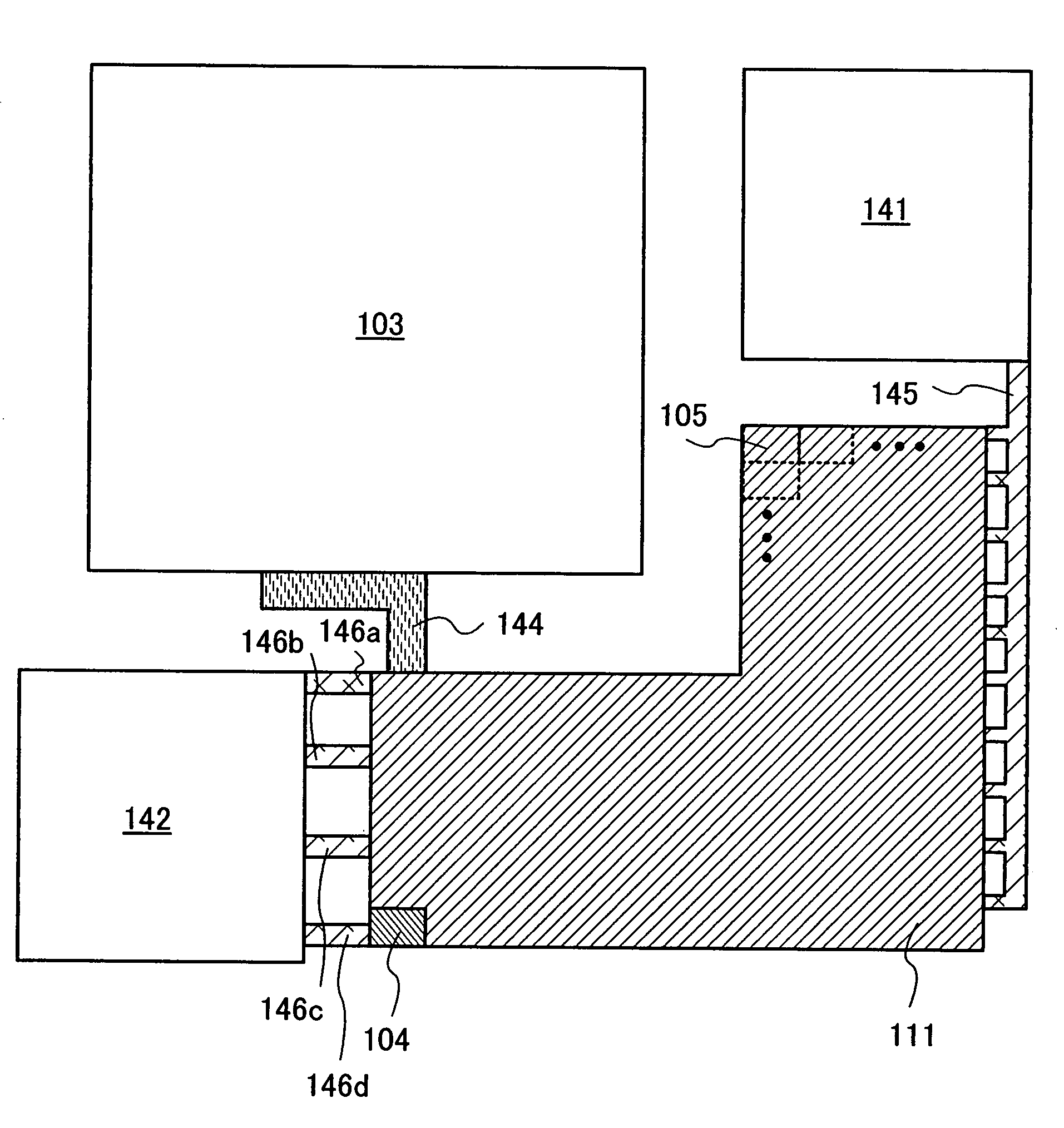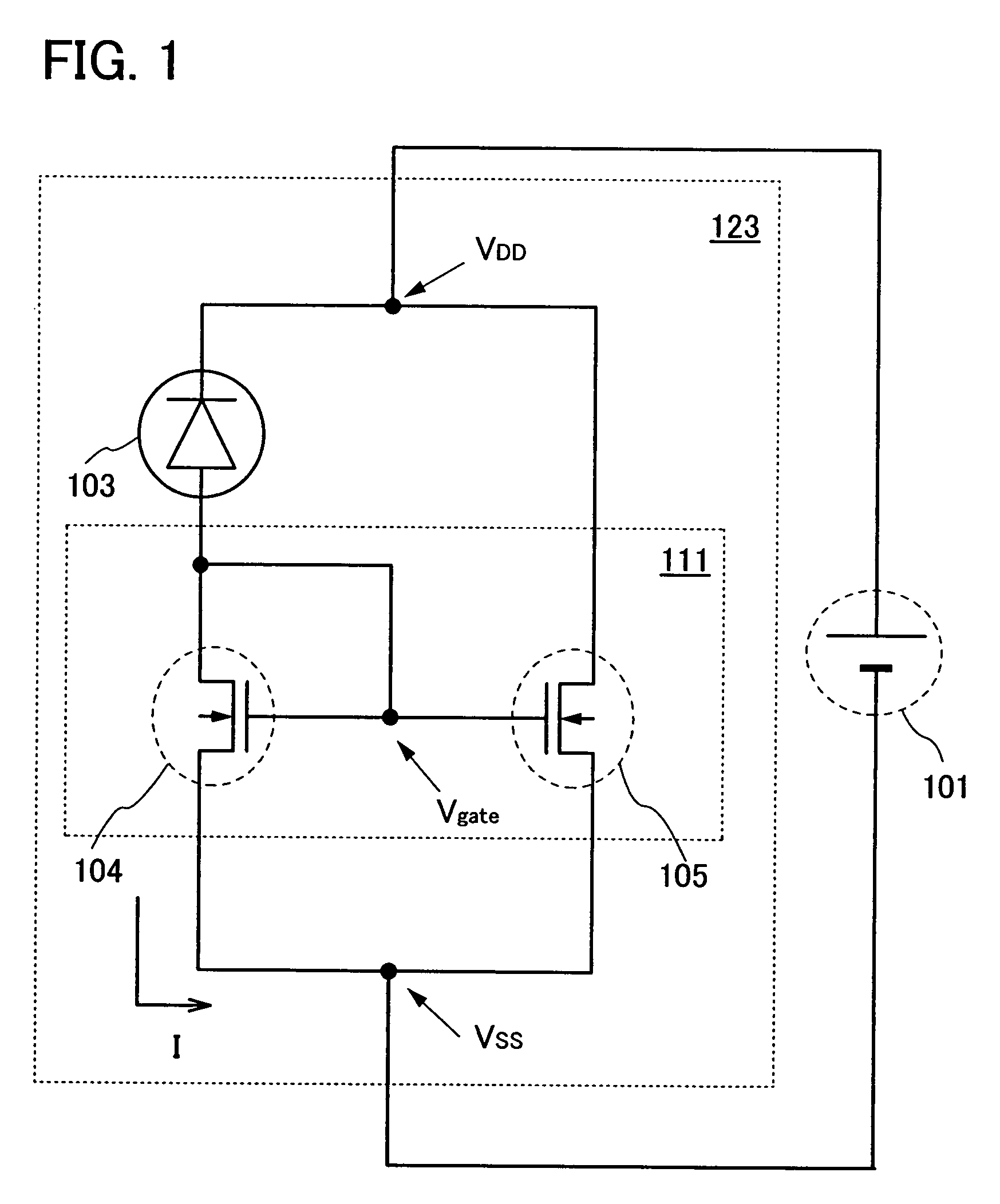Semiconductor device comprising photoelectric conversion element and high-potential and low-potential electrodes
a technology of photoelectric conversion element and semiconductor device, which is applied in the direction of optical radiation measurement, pulse technique, instruments, etc., can solve the problems of reducing the detection range of light intensity, requiring a high power supply voltage, and generating parasitic resistance, so as to reduce the photosensitivity and reduce the generation of parasitic resistance , the effect of stable circuit operation
- Summary
- Abstract
- Description
- Claims
- Application Information
AI Technical Summary
Benefits of technology
Problems solved by technology
Method used
Image
Examples
embodiment mode 1
[0057]Embodiment Mode 1 will be described below with reference to FIGS. 1 through 14C.
[0058]Note that the invention can be implemented in various different ways and it will be easily understood by those skilled in the art that various changes and modifications can be made in the invention without departing from the spirit and scope thereof. Therefore, the invention should not be construed as being limited to the description of the following embodiment modes.
[0059]Note also that in all the drawings illustrating embodiment modes, portions that are the same or portions having a similar function are denoted by the same reference numerals, and repetitive description thereof will be omitted.
[0060]A semiconductor device of this embodiment mode includes, as shown in FIG. 1, a current mirror circuit 111 having transistors 104 and 105 and a power supply (bias) 101. In this embodiment mode, thin film transistors (TFTs) are used as the transistors 104 and 105. In addition, the TFTs 104 and 105 ...
embodiment mode 2
[0160]This embodiment mode will describe an example of an amplifier circuit constructed from p-channel TFTs with reference to FIGS. 9 and 15. Note that portions common to this embodiment and Embodiment Mode 1 are denoted by common reference numerals. Therefore, such portions may be formed through the same fabrication steps as those described in Embodiment Mode 1.
[0161]When an amplifier circuit, e.g., the current mirror circuit 203 is constructed from the p-channel TFTs 201 and 202, the impurity which imparts one conductivity type to the island-shaped semiconductor regions in Embodiment Mode 1 may be replaced with a p-type impurity, e.g., boron (B).
[0162]FIG. 9 is an equivalent circuit diagram of a photosensor in this embodiment mode in the case where the current mirror circuit 203 is constructed from the p-channel TFTs 201 and 202, and FIG. 15 is a cross-sectional view thereof.
[0163]In FIGS. 9 and 15, the terminal electrode 221 is electrically connected to the n-type semiconductor l...
embodiment mode 3
[0170]This embodiment mode will describe a photosensor and an amplifier circuit constructed from bottom-gate TFTs, and a method of fabricating them, with reference to FIG. 16A through 18. Note that portions common to this embodiment and Embodiment Modes 1 and 2 are denoted by common reference numerals.
[0171]First, a base insulating film 212 and a metal film 311 are formed over a substrate 210 (see FIG. 16A). In this embodiment mode, a stacked film of, for example, tantalum nitride with a thickness of 30 nm and tungsten (W) with a thickness of 370 nm is used as the metal film 311.
[0172]Besides, the metal film 311 can also be formed using a single-layer film made of an element selected from titanium (Ti), tungsten (W), tantalum (Ta), molybdenum (Mo), neodymium (Nd), cobalt (Co), zirconium (Zr), zinc (Zn), ruthenium (Ru), rhodium (Rh), palladium (Pd), osmium (Os), iridium (Ir), platinum (Pt), aluminum (Al), gold (Au), silver (Ag), or copper (Cu); a single-layer film made of an alloy ma...
PUM
 Login to View More
Login to View More Abstract
Description
Claims
Application Information
 Login to View More
Login to View More - R&D
- Intellectual Property
- Life Sciences
- Materials
- Tech Scout
- Unparalleled Data Quality
- Higher Quality Content
- 60% Fewer Hallucinations
Browse by: Latest US Patents, China's latest patents, Technical Efficacy Thesaurus, Application Domain, Technology Topic, Popular Technical Reports.
© 2025 PatSnap. All rights reserved.Legal|Privacy policy|Modern Slavery Act Transparency Statement|Sitemap|About US| Contact US: help@patsnap.com



